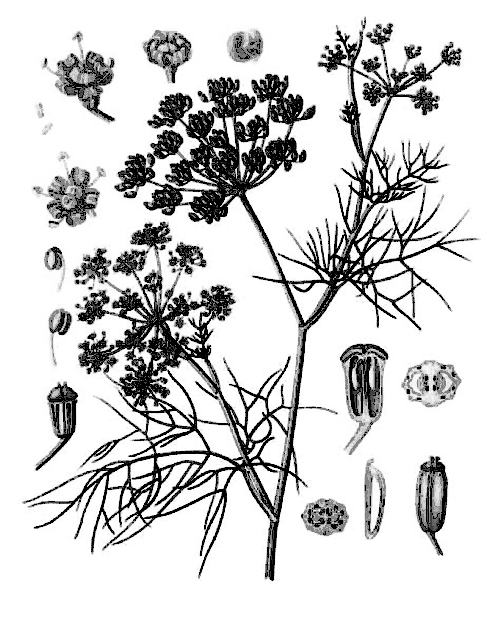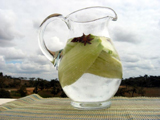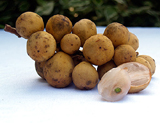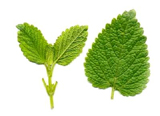Medicinal plants
Madhurikā, saunf or fennel (Foeniculum vulgare, Gaertn.)
Fennel is an ancient seasoning herb, a native of the Mediterranean region, but now found in many parts of the world. It is cultivated in fields or grows wild as an escape. The herb was well-known to the ancient Egyptians, Romans, Indians and Chinese. The Romans grew it for its aromatic seeds and the edible fleshy shoots are still a very common vegetable in southern Italy. Emperor Charlemagne was known to have encouraged its cultivation in Central Europe. It is an indispensable ingredient in modern French and Italian cooking. All parts of the plant are aromatic and can be used in many ways. It is a tall, perennial herb with finely divided leaves and yellow flowers. The fruits are oval, a greenish or yellowish-brown and are used for cooking, pickle and candy making and flavouring liquors. The oil is used in perfumes, soaps and medicines. The thickened leaf stalks of the Florence variety are blanched and used as a vegetable delicacy.
Cultivated fennels differ so much from the wild fennels that they are presumed to be a sub-species or different races of Foeniculum vulgare. They differ in the size of fruit and the odour, taste and contents of the essential oil. They are, however, hardly distinguishable botanically. Foreign fennel is usually bigger than the Indian fennel. Hence it is called badā saunf.
At present, fennel is one of the commonest culinary spices of the world. It is also a well-recognised medicinal plant and has been included in the pharmacopoeia or official list of medicinals of every country due to its volatile oil, which is a stimulant, aromatic, diuretic, emenagogue, purgative and carminative. Mixed with sodium bicarbonate and syrup, it is also given to infants for flatulence. It is also a well-liked and commonly used masticatory, chewed by many Indians to remove any foul smells from the mouth.
It is much used in Europe for manufacturing drugs meant for the heart and is also an ingredient of fennel water, mostly employed as a medium for other medicines and as a flavouring agent. Indigenous medicine in India invariably has a great demand for fennel. Its hot infusion is commonly given to increase milk secretion and to induce profuse sweating.
Saunf is grown in India as a cold weather crop. India has been annually exporting nearly 500,000 kilograms of the fruit. But with really extensive potential resources, there is great potential to enhance the export market, especially to France. Indian fennel oil compares favourably with that of foreign countries and industrialists could concentrate more on exporting the oil than the fruits. This oil is an aromatic carminative, much preferred for treating colic pains in children. In Europe it is greatly used in cooking and in manufacturing cordials and liquors. It is not much used in perfumery except sometimes for scenting soaps.

Courtesy: Köhler’s Medicinal Plants, 1987 from Wikipedia
http://en.wikipedia.org/wiki/Fennel
Sanskrit calls this herb madhurikā, mādhurī (the sweet), miśreya, miśrt (Egyptian).In Hindi, it is known as saunf, badi saunf, saunp; in Bengali, as mauri, pānmourī; in Marathi as badishep; in Gujarati as hariyal, variyali; in Kannada, as dodda sopu, dodda jirige, badi sopu; in Sindhi, as saunf; in Telugu, as sopu, pedda jilakura; in Tamil, as shombu, sohikire.
Botanical aspects
The herb grows to a height of 2-3 feet. It has a green, sleek and slippery stem with upright stiff branches and much divided leaves in linear segments. The fruits are elongated and have strong ribs. They are a greenish-yellow, the colour of hay, which is what the term fennel means.
Constituents
The fruit after distillation of the essential oil provides a valuable cattle feed as it contains 14-22 per cent of proteins and 12-20 per cent of fat.
The nutritional (percentage) value of fennel used as a pot herb is as follows: 4.9 protein, 0.9 fat, 9.8 carbohydrates and 1.6 mineral salts; caloric or energy value is 67. The seeds contain 3-5 per cent essential, aromatic oil of light yellow colour. The active principles are anethole and fenchone.
Medicinal and other Importance
Āyurveda considers it sweet, bitter and pungent in taste; light, oily and acute in quality; hot in virility and sweet in post-assimilation. It is simulating, milk-augmenting, taste-promoting and alleviates wounds and ulcers, fevers, eye sores and eye diseases, spleenic problems, and is useful against shooting pains, thirst, vomiting and dysentery.
The dried ripe fruits and their essential oil are used as stimulants, aromatics, carminatives, diuretics, emmenagogics (ie. regulating menstrual flow) and purgatives. Its root is one of the five famous purgatives of Europe, the others being parsley, wild celery, asparagus and butcher’s broom (Ruscus aculatus). Its leaves are used as a vegetable; they promote ample urination and perspiration. The juice of fennel improves eyesight. A paste made from the seeds forms a cooling drink during fever and is preferred when urination is accompanied with a burning sensation. Arabic and Persian physicians often combine fennel and anise.
Yūnānī physicians consider saunf as 2º hot and dry. It breaks obstruction in the stomach, destroys gas and produces much belching. It corrects any undigested residue and is very good for stomach upsets. It forms a very good vehicle for any medicine. Its seeds are advised to be eaten to improve eyesight and used as a colyrium for the eyes to be dipped in their decoction or fresh juice and then applied. It is best for dissolving phlegm, promoting urination and regulating menstrual flow.
Saunf as a household remedy
Some specific and simple uses of saunf are as follows:
I. Bad breath
From ancient times, saunf has been used an ingredient for removing any foul smell of the mouth. Keep chewing 3 māṣās of fennel for a few days.
II. Stomach problems
Distilled saunf water is a popular remedy for vomiting during fever as well as any distressing stomach cramps. It is advised that every household should always keep some saunf in store due to its innumerable uses. Bruise the fruits, take a handful of them, grind with water and consume to enliven the brain, ward off constipation and strengthen the stomach.
III. Headache
Put 1 tolā of saunf in 40 tolās of water and cook over a mild fire, stirring all the while till only 10 tolās of water remain. This liquid is very beneficial for headaches.
IV. Dizziness of the head
This will stop very soon after taking 6 māṣās each of saunf powder and sugar.
V. Sleeplessness
Take 6 māṣās of fennel, 40 tolās of water and prepare a decoction by boiling till the water is reduced to one-fourth. Add ghee and cow’s milk and keep taking.
VI. Insanity
Cook 1 tolā of fennel in 12 catānks of water till the liquid is reduced to a half, then add sugar candy and give as a drink. This eliminates insanity due to vāyu and pitta. Cook 1 tolā of fennel in 4 catānks (20 tolās) of water; add country sugar and drink to eliminate insanity due to pitta.
VII. Colds and fever
Prepare a decoction of 1 tolā of pounded fennel and 2 tolās of country sugar in half a ser of water till the liquid is reduced to one-fourth, then strain and administer repeatedly.
VIII. Chest troubles and hoarseness in voice
One tolā of pounded fennel is to be cooked in half a ser of water till reduced to one-fourth. Strain, add sugar candy and give while still warm. This is particularly good for any loss of voice.
IX. Heaviness of stomach
Pound a handful of fennel and take it morning and evening with some water. Alternatively, keep 5 tolās of fennel powder in 15 tolās of gulkand (a confection of rose petals) and consume 5 tolās morning and evening. This eliminates heaviness and is also beneficial against constipation.
X. Flatulence
Take 2 tolās of fennel in one ser of water, cook till it is reduced to a quarter, strain, add saindhav salt and black salt, each 2 māṣās, and then consume over a few days.
XI. Digestive trouble in children
Take one tolā of fennel, cook in half a ser of water till reduced to a half. Add 3 māṣās of friend borax (suhāgā) and one pāv of country sugar and make a sherbet. This is both tasty and salutary. The dosage is 1-2 māṣās
Bibliography
1. K.M. Nadkarni. Indian Materia Medica, Vol. I. Mumbai; Popular Prakashan Private Ltd., 1982.
2. K.R. Kirtikar and B.D. Basu. Indian Medicinal Plants, Vol II. Dehradun; International Book Distribution, 1988.
3. Naveen Patnaik. The Garden of Life. New Delhi; Harper Collins Publishers, 1993.
4. N.K. Shanmugam. Mooligai Kalai Kalanjium. Chennai; Kalaiselvi Publications, 1997.
5. P.K. Warrier, V.P. Nambiar, C. Raman-kutty. Indian Medicinal Plants. Chennai; Orient Longman Limited, 1996.
6. The Wealth of India. New Delhi; Publications and Information Directorate, CSIR, 1976, [Vol.X]: 171-7.
7. The Useful Plants of India. New Delhi; Publications and Informations Directorate, CSIR, 1986.
8. Bhandari, Chandraraj. Vanauṣadhī Cand-rodaya. Varanasi; Chaukhambha Sanskrit series, 1970.
The modern equivalents of the measures used in this text are:
1 rattī = 1 guñjā (seed of Abrus precatorius)
8 rattīs = 1 māṣā 1 ser = approx. 1 litre
10 māṣā = 1 tolā 1 pāv = 250ml.
1 tolā = 10gm.
Dr. K.H. Krishnamurthy wrote about medicinal plants as used in the Indian context with deep interest.
Share with us (Comments, contributions, opinions)
When reproducing this feature, please credit NAMAH, and give the byline. Please send us cuttings.






